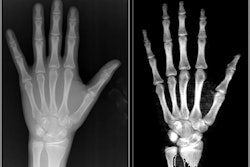
Dual-energy x-ray absorptiometry (DEXA) exams suggest that in utero exposure to synthetic manufacturing chemicals may weaken the bone health of adolescents later in life, according to a study published August 26 in Science of the Total Environment.
A team of U.S. researchers studied associations between bone health measured by DEXA and early-life exposure to organophosphate esters (OPEs), chemicals found in many household items. The group found that early-life OPE exposure may weaken adolescent bone mineral accrual and strength.
"Since 95% of adult total body bone mass is achieved within a few years of puberty, identifying modifiable early life risk factors is critically important for fostering optimal skeletal health throughout life," wrote corresponding author Jessie Buckley, PhD, of the Johns Hopkins Bloomberg School of Public Health in Baltimore and colleagues.
OPEs are synthetic flame retardants and plasticizers used in items such as clothing, furniture foam, electronics, baby products, and nail polish. These chemicals were introduced to the market as a replacement for polybrominated diphenyl ethers, which were voluntarily phased out by manufacturers in the mid-2000s due to concerns about toxicity.
Given the increasing industrial demand and potential health effects of OPEs, human exposure to OPEs is of great concern. Recent lab studies and one animal study in rats suggest that OPEs may exhibit osteotoxic effects, according to the authors.
"No human studies have evaluated early life organophosphate ester (OPE) exposures with bone health outcomes, despite evidence of osteotoxicity," they wrote.
In this study, the researchers studied data in 223 pregnant women living in the Cincinnati, OH, area who had participated in a previous study. Participants had concentrations of four specific OPEs measured in their urine during pregnancy. The chemicals were also measured in their children at 1, 2, 3, 5, and 8 years old.
 A graphical abstract of the study. Image courtesy of Science of the Total Environment.
A graphical abstract of the study. Image courtesy of Science of the Total Environment.At age 12, the children underwent DEXA exams (Horizon DXA, Hologic) of the whole body, lumbar spine, hip, and forearm, which were used to measure their areal bone mineral density (aBMD) at six skeletal sites.
According to the analysis, overall associations of the OPEs and bone health measures varied significantly by exposure time point. Greater OPE concentrations at 1-3 years and 5 years were generally associated with lower aBMD scores at most skeletal sites. Specifically, an increase in OPE concentration at 1-3 years and 5 years was associated with a -0.15 and -0.17 lower total hip aBMD score.
"We estimated effects of OPE metabolite concentrations at several time points across early life, including gestation, to inform the developmental periods that may be most susceptible to OPE osteotoxicity," the authors wrote.
Ultimately, the exact mechanisms by which OPEs may exert effects on bone homeostatic processes are not well established, with endocrine disruption as one possibility, given that bone homeostasis is a process regulated by hormones, the researchers wrote.
Additional studies are warranted, they noted.
"Future studies assessing clinical outcomes, such as fracture and osteoporosis, can help contextualize the potential long-term health implications of early childhood OPE exposures," Buckley and colleagues concluded.




















